The ratings agency Fitch has adjusted its forecast for China’s policy rate cuts, now anticipating that a reduction will not occur until next year. This change in outlook comes as a result of the U.S. Federal Reserve maintaining high interest rates, which has implications for global monetary policy decisions. Fitch’s latest projection suggests that China will maintain its one-year medium-term lending facility (MLF) rate at 2.5% for the remainder of this year before potentially reducing it to 2.25% in the following year.
According to Jeremy Zook, Fitch Ratings’ head of sovereign rating in Asia Pacific, there are several factors influencing this decision. Concerns related to the exchange rate between the Chinese yuan and the U.S. dollar, driven by shifting expectations regarding the Fed’s actions, are constraining the People’s Bank of China (PBOC) in its monetary policy decisions. The anticipation of the Fed initiating rate cuts in the near future may provide the PBOC with more flexibility to adjust its own rates.
Zook also anticipates that Beijing will rely more heavily on fiscal policy measures in the current year. The decision to delay rate cuts may prompt the Chinese government to explore alternative methods for stimulating economic growth and stability. This shift towards utilizing fiscal tools highlights the interconnected nature of monetary and fiscal policies within the broader economic landscape.
One of the challenges facing the PBOC is the impact of low bank net interest margins on the financial sector. With NIM serving as a crucial indicator of bank profitability, the persistence of low margins presents obstacles for the central bank. The relationship between interest rates, bank profitability, and overall economic health underscores the complexity of managing monetary policy in a dynamic global environment.
The one-year MLF rate, which the PBOC adjusts monthly, plays a significant role in shaping the benchmark loan prime rate (LPR) utilized by financial institutions. This interconnected relationship between various interest rates underscores the PBOC’s influence on the broader financial system. The decision-making process surrounding these rates reflects the ongoing challenges and considerations that policymakers must navigate.
Despite the uncertainties surrounding rate cuts, PBOC Governor Pan Gongsheng emphasized the institution’s commitment to maintaining a supportive monetary policy stance. In the face of evolving global economic conditions, the stability of China’s monetary policy remains a key priority. The balancing act between stimulating economic growth and addressing external pressures exemplifies the complexities inherent in managing a large and diverse economy.
The evolving landscape of global monetary policy, accentuated by the actions of major economies like the United States, has a direct impact on China’s policy decisions. The careful consideration of various factors, ranging from exchange rates to bank profitability, underscores the challenges facing the PBOC in its pursuit of economic stability. As uncertainties persist, the adaptability and responsiveness of China’s monetary authorities will be crucial in navigating the complexities of a rapidly changing economic environment.

